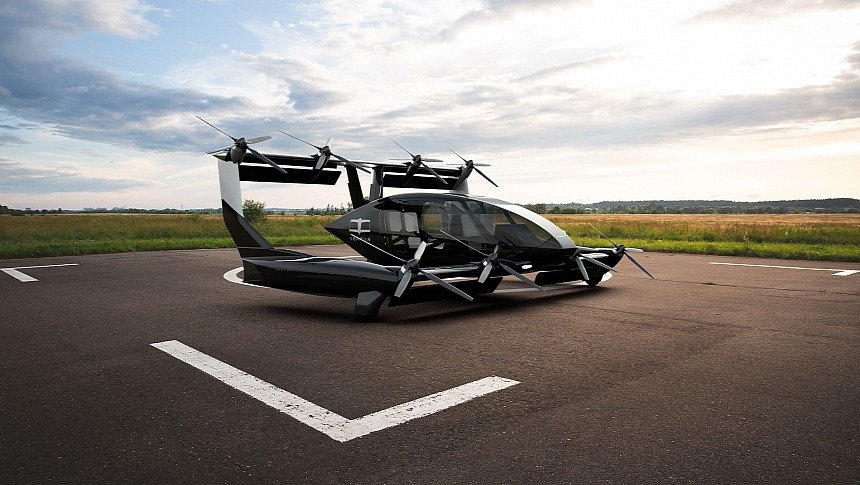Vertiia is a name worth remembering. When it soars to the sky, it will officially become the first eVTOL (electric vertical takeoff and landing) designed and built in Australia. It even claims to be among the world's most efficient zero-emission aircraft of its kind because it will run on renewable hydrogen.
Today's electric air taxis promise a lot of things, but long range isn't one of them. Battery technology isn't at the point where it can allow purely electric aircraft to cover long-distance routes. But an extensive range is precisely the main focus for Australian startup AMSL Aero. The way to achieve that without compromising zero-emission operations is by bringing hydrogen into the picture. Not just any type of hydrogen, but green hydrogen that is obtained from renewable sources, which makes it sustainable.
This is how Vertiia can be one of the few eVTOLs to promise an impressive 1,000 km (621 miles) range. AMSL Aero is currently working on a dedicated hydrogen fuel cell system for this aircraft, and it has the money to do it. That's because the company was recently awarded A$5.43 million ($3.4 million) by the Australian Renewable Energy Agency (ARENA). This significant boost will help the startup speed up its development process on the path to certification.
On the other hand, this isn't just about bringing electric air taxis to the market but also about supporting a domestic green hydrogen industry. As alternative fuels and sustainable sources of energy are becoming increasingly important for all means of transportation in the future, it's crucial for countries to develop a strong supply chain based on local resources as much as possible.
Earlier this year, the Vertiia zero-emission aircraft made its public debut at the Avalon International Show in Victoria, Australia. The hybrid-electric VTOL boasts a four-passenger configuration (plus the pilot).
It looks different than most eVTOLs on the market because of the so-called box-wing design. It describes an atypical wing configuration that outlines a rectangular shape. Thanks to this, Vertiia is able to generate more lift compared to aircraft with a similar wingspan.
This innovative approach is actually derived from a design that's more than 100 years old: the box kite. It was invented by the Australian Lawrence Hargrave, and today, another talented Australian, Andrew Moore, has adapted this configuration for eVTOLs. Moore, a pilot and an aeronautical engineer, is the man behind the Vertiia concept.
Like many eVTOLs, Vertiia will also be flexible enough to fulfill a wide variety of roles. It's not meant to be just an air taxi for urban commutes but also to bring major advantages to ambulances and other emergency ambulances. Plus, the extensive range makes it particularly well-suited for air transportation in Australia's most remote regions.
This is how Vertiia can be one of the few eVTOLs to promise an impressive 1,000 km (621 miles) range. AMSL Aero is currently working on a dedicated hydrogen fuel cell system for this aircraft, and it has the money to do it. That's because the company was recently awarded A$5.43 million ($3.4 million) by the Australian Renewable Energy Agency (ARENA). This significant boost will help the startup speed up its development process on the path to certification.
On the other hand, this isn't just about bringing electric air taxis to the market but also about supporting a domestic green hydrogen industry. As alternative fuels and sustainable sources of energy are becoming increasingly important for all means of transportation in the future, it's crucial for countries to develop a strong supply chain based on local resources as much as possible.
Earlier this year, the Vertiia zero-emission aircraft made its public debut at the Avalon International Show in Victoria, Australia. The hybrid-electric VTOL boasts a four-passenger configuration (plus the pilot).
It looks different than most eVTOLs on the market because of the so-called box-wing design. It describes an atypical wing configuration that outlines a rectangular shape. Thanks to this, Vertiia is able to generate more lift compared to aircraft with a similar wingspan.
This innovative approach is actually derived from a design that's more than 100 years old: the box kite. It was invented by the Australian Lawrence Hargrave, and today, another talented Australian, Andrew Moore, has adapted this configuration for eVTOLs. Moore, a pilot and an aeronautical engineer, is the man behind the Vertiia concept.
Like many eVTOLs, Vertiia will also be flexible enough to fulfill a wide variety of roles. It's not meant to be just an air taxi for urban commutes but also to bring major advantages to ambulances and other emergency ambulances. Plus, the extensive range makes it particularly well-suited for air transportation in Australia's most remote regions.







